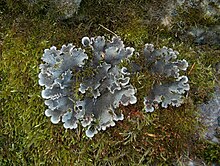Peltigeraceae
| Peltigeraceae | |
|---|---|

| |
| Peltigera canina is the type species of genus Peltigera | |
| Scientific classification | |
| Domain: | Eukaryota |
| Kingdom: | Fungi |
| Division: | Ascomycota |
| Class: | Lecanoromycetes |
| Order: | Peltigerales |
| Family: | Peltigeraceae Dumort. (1822) |
| Type genus | |
| Peltigera Willd. (1787)
| |
| Subfamilies | |
|
Lobarioideae | |
| Synonyms[1] | |
| |
The Peltigeraceae are a
are common in this family.Taxonomy
The family Peltigeraceae was circumscribed by Belgian botanist Barthélemy Charles Joseph Dumortier in 1822.[2] Using a temporal approach that uses time-calibrated chronograms to identify and define temporal bands for comparable ordinal and family ranks in the Lecanoromycetes, the families Lobariaceae and Nephromataceae were synonymized with Peltigeraceae in 2018.[3] In a later critical review of the use of this method for the biological classification of lichens, Robert Lücking considered this merge justified based on several characteristics shared by all three groups. These include "the leathery structure of their usually large and conspicuous thalli, apothecial morphology and anatomy, ascus and ascospore type, and the fact that tripartite thalli or photosymbiodemes involving green algae and cyanobacteria are common".[4] The proposed synonymy was also accepted in a 2020 review of fungal classification.[1]
Since the two synonymized families have been widely used, and have been accepted previously as
- Lobarioideae Lumbsch & S.D.Leav. (2019)
- Nephromatoideae Lumbsch & S.D.Leav. (2019)
According to Lumbsch and Leavitt, Peltigeroideae becomes an
Genera
A 2020 estimate placed 15 genera and about 600 species in the Peltigeraceae,
- Lobarioideae
- Crocodia Link (1833)[8] – 5 spp.
- Dendriscosticta Moncada & Lücking (2013)[9] – 5 spp.
- Lobaria (Schreb.) Hoffm. (1796) – ca. 60 spp.
- Lobariella Yoshim. (2002) – 35 spp.
- Lobarina Nyl. ex Cromb. (1894) – 15 spp.
- Podostictina Clem. (1909)[10] – 5 spp.
- Pseudocyphellaria Vain. (1890)[11] – ca. 100 spp.
- Ricasolia De Not. (1846)[12]– 15 spp.
- Sticta (Schreb.) Ach. (1803) – ca. 200 spp.
- Yarrumia D.J.Galloway (2015)[13] – 2 spp.
- Yoshimuriella Moncada & Lücking (2013)[9] – 8 spp.
- Nephromatoideae
- Peltigeroideae
- Emmanuelia Ant.Simon, Lücking & Goffinet (2020)[6] – 12 spp.
- Peltigera Willd. (1787)[15] – ca. 100 spp.
- Sinuicella D.F.Stone, McCune & Miądl. (2021)[7] – 1 sp.
- Solorina Ach. (1808)[16] – ca. 10 spp.
Uses
Many species of Peltigeraceae have been used in studies on
Conservation
As of March 2022[update], Peltigeraceae species that have been assessed for the global
References
- ^ S2CID 218933904.
- .
- .
- S2CID 202859785.
- ^ S2CID 199630053.
- ^ .
- ^ S2CID 232271452.
- ^ Link, Heinrich Friedrich (1833). Handbuch zur Erkennung der nutzbarsten und am häufigsten vorkommenden Gewächse (in Latin). Vol. 3. Berlin: Spenerschen Buchhandlung. p. 177.
- ^ S2CID 86082520.
- ^ Clements, F.E. (1909). The Genera of Fungi. Pennsylvania: H. W. Wilson Company. pp. 82, 175.
- ^ Vainio, E.A. (1890). "Étude sur la classification naturelle et la morphologie des Lichens du Brésil. Pars prima". Acta Societatis Pro Fauna et Flora Fennica (in Latin). 7 (1): 182.
- ^ De Notaris, G. (1846). "Frammenti lichenografici di un lavoro inedito". Giornale Botanico Italiano (in Italian). 2 (1): 174–224 [178].
- ISSN 1179-3163.
- ^ Luyken, Johann Albert (1809). Tentamen Historiae Lichenum in Genere, cui Accedunt Primae Lineae Distributionis Novae (in Latin). Gottingen: Typis Henrici Dieterich. p. 92.
- ^ Willdenow, C.L. von (1787). Florae Berolinensis Prodromus (in Latin). Berlin: Impensis Wilhelmi Viewegii. p. 347.
- ^ Acharius, E. (1808). "Förteckning på de i Sverige våxande arter af Lafvarnas Familj". Kongliga Vetenskaps Academiens Nya Handlingar (in Latin). 29: 228–237.
- ^ Lendemer, J. (22 July 2020). "Sticta deyana". The IUCN Red List of Threatened Species 2020. Retrieved 5 March 2022.
- ^ Lendemer, J. (1 August 2020). "Sticta deyana". The IUCN Red List of Threatened Species 2020. Retrieved 5 March 2022.
- ^ Thor, G.; Aptroot, A. (30 August 2017). "Sticta alpinotropica". The IUCN Red List of Threatened Species 2017. Retrieved 5 March 2022.
- ^ Lendemer, J. (15 July 2020). "Sticta fragilinata". The IUCN Red List of Threatened Species 2020. Retrieved 5 March 2022.
